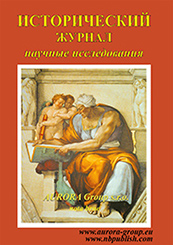Academic schools and paradigms
Reference:
Berezkina O.S. (2015). Political elites: history of research in the 20th century. History magazine - researches, 1, 11–23. https://en.nbpublish.com/library_read_article.php?id=66599
Abstract:
The article presents the key problems featured in the study of political elites by Western scholars during the 20th century. The author indicates the various directions in the study of elites in contemporary disciplines of socio-humanities. The elite theories are reviewed from the point of view of the historical approach – through their development in time and in correlation with the specific historical circumstances of their formation. The author notes that the classic elite theories, formulated at the end of the 19th – beginning of the 20th centuries, proposed an alternative approach to the historical process in contrast with the Marxist one. The most significant differences in these approaches concerned the nature of the ruling class, the outlook of the class conflict, and the creation of an egalitarian society. During the 20th century there was an intensive study of political elites, however it did not lead to the elaboration of a single generally-accepted theory explaining the functioning of contemporary societies. Scholars came to opposing conclusions, closely tied with the different methodological directives and priorities in their selection of factual material. The main effort was aimed at addressing the issue of the relationship between elites and democracy. The tendency to dissociate from the classic elite theories dominated, due to which the methodological entirety was lost and an array of definitions and interpretations appeared. At the same time, Western authors offered numerous instruments for identifying and analysing political elites, in principle applicable to any society. The use of the existing groundwork by scholars of diverse approaches can facilitate the broadening of interdisciplinary studies.
Keywords:
S. Nadel, democratic process, political elite, ruling class, directions of elites research, Marxism, elitism, A. Giddens, methodology, interdisciplinary studies
Comparative history research
Reference:
Pavliv A.A. (2015). Statehood development in Russia in perspective with analogous processes in England and France (pre-Revolutionary period). History magazine - researches, 1, 24–35. https://en.nbpublish.com/library_read_article.php?id=66600
Abstract:
The article focuses on the development of the Russian state in the pre-Revolution period (1380–1917) in a comparative analysis with England (1066–1640) and France (1214–1789). The research subject is the same periods of development in the lives of these three countries: liege monarchy, estate-representative monarchy, absolutism. The author traces the evolution of separate statehood elements (army, government, representative bodies in the centre and locally). Particular attention is given to the relationship between state and church. The aim is to construct a clear synchronised statehood development pattern in the above-named countries. The method of comparative analysis is used. The article examines the analogous processes and events in these three countries. The study’s novelty is that it is the first given comparative analysis of the unfolding analogous processes in the history of Russia, England, and France during the course of several centuries. The main conclusions resulting from the study are the following: modern England originated in 1066, France – 1214, Russia – 1380. This is why the analogous statehood processes “lag behind” England by about 150 years in France and by about 300 years in Russia. The equivalent of the English Magna Carta (1215) is the French Great ordinance (1357) and the Cross-oath charter of Vasiliy Shuysky (1606) in Russia. The parallels of the English parliament (1265) are the French Estates general (1413) and Russia’s Zemsky sobor (1565). The concept of a capitalist formation period in Russia from 1861 to 1917 is criticised, and it is asserted that with the beginning of the Revolution in Russia in 1917 began the Great Russian bourgeois revolution, which ended in 1991 with the dissolution of the USSR and the collapse of the communist regime. This revolution marked the beginning of the so-called capitalist era in the history of the Slav-Orthodox linguistic-religious population groups.
Keywords:
absolutism, estate-representative monarchy, liege monarchy, dominant state, linguistic-religious population groups, representative body, parliament, analogous development periods, government, army
Interdisciplinary research
Reference:
Korolev S.A. (2015). Phenomenon of pseudomorphosis: an attempt of reinterpretation. History magazine - researches, 1, 36–46. https://en.nbpublish.com/library_read_article.php?id=66601
Abstract:
The article discusses the possibilities and prerequisites for the re-actualisation of the concept of pseudomorphosis under contemporary conditions. The reference point in the author’s research is the conceptualisation by Oswald Spengler. The author defines pseudomorphosis not only as a global historical shift, a turning point in the development of a society, but also considers pseudomorphosism as a sort of defining characteristic, a quality inherent to the process of historical development, and defined by the significant role of the pseudomorphosis phenomenon in the history of one or another macro-culture. Based on the fact that the main instrument of any scientific research is its conceptual framework, the author describes the basic concepts used in the context of the pseudomorphic development theory of Russia: pseudomorphosis, reception, inversion; in addition, the author introduces the concept of local pseudomorphic space. The novelty of the author’s approach stems from regarding pseudomorphosis not only as a specific historical phenomenon, but also as a type of development inherent in some countries, including in Russia. This implies a broader understanding of this phenomenon than was prescribed by Spengler. The author draws attention to the issue of the reception of socio-cultural content during the process of pseudomorphosis, which can be borrowed incompletely, selectively, partially. Finally, the proposed conceptualisation involves the understanding of the mechanisms of pseudomorphic development, in particular, the phenomenon of inversion and “revenge” of the repressed autochthonous content.
Keywords:
Spengler, Christianisation, politics, culture, inversion, reception, pseudomorphosis, history, Florovsky, Tsymbursky
HISTORIOGRAPHY AND SOURCE STUDIES
Reference:
Kuz'mina A.V. (2015). The use of material from private possession for the study of industrial enterprises in Sevastopol. History magazine - researches, 1, 47–52. https://en.nbpublish.com/library_read_article.php?id=66602
Abstract:
The article exposes the particularities of using material from private papers and oral history in filling the gaps of the sources on the history of industrial enterprises in Sevastopol, based on the example of food industry production enterprises. The article presents the results from interviews conducted by the author with employees, veterans, and enterprise managers; analyses the possibilities in using private archives for the restoration of the losses in the source base for the history of the Soviet industry in Sevastopol; reviews the methodology of searching for interviewees, working with materials from personal possession and oral history; assesses the significance of such data for the studied period. The author affirms that only a comprehensive review of all the source groups – archival data and record documentation, representative material, sources in private possession – permits to reconstruct the picture of an enterprise’s functioning. A scholar studying the Soviet industry in Sevastopol often faces the problem of the enormous losses in the source base, of fragmentary, badly preserved archival funds. In such cases, resorting to the material from oral history, private collections, and individuals–eyewitnesses of events becomes indispensable. The period in question provides a unique possibility not only to study, but also to actually create new historical sources for future generations of researchers, to preserve the memory of the industrial tradition and of the at times difficult, heroic pages in the city’s history.
Keywords:
Crimean industry, oral history, methodology for the study of industry, problems of source study, Sevastopol winery, personal archives, Soviet industry, Sevastopol, history of entrepreneurship, Crimean wine-making
Ethnography and ethnology
Reference:
Solovey T.D. (2015). Between intuition and reason: research strategies in ethnological studies. History magazine - researches, 1, 53–61. https://en.nbpublish.com/library_read_article.php?id=66603
Abstract:
Although the structure and content of the “ethnography field” has radically transformed and the science of ethnography itself, clearly, is reorienting from the ethnic to the cultural-anthropological sphere, the myth of ethnography as a predominantly field discipline maintains its inertial influence in the professional environment. However, scientific practices – in the past and currently – attest to a multitude of research strategies (including their diverse combinations), rather than to the domination of a single one. The efficacy of one or another strategy is defined by its scientific fecundity. In the author’s hypothesis, empiricism and theoretical generalisation are not different stages, but are qualitatively diverse forms of scientific activity. Facts do not precede theory, but exactly the opposite: theory, setting forth an observation angle and structuring our perception of reality, shapes the subject field of science. Facts outside of theory do not exist. Yet the theory itself also has a starting point, which is based on a scientist’s pre-theoretical experience. Our ideological and political beliefs, our cultural baggage, and even our individual psychological profile and personal temperament, if do not strictly define, at least predispose towards the choice of a particular research position. Thus, a scientist’s chosen strategy is not so much a projection of rational calculations, as much as an intuitive (unconscious) inclination. Objective circumstances – ideological and political context, cultural and moral backgrounds, development level of the scientific discipline, type of socialisation – inevitably pass a succession of mediations through the human mentality. Only in this case can they have an influence on a researcher’s scientific priorities.
Keywords:
Dmitry Nikolaevich Anuchin, Nikolai Nikolaevich Miklouho-Maclay, , nationality discourse, strategies in ethnography, ethnographic field, history of Russian ethnological studies, Siberian “regionalism”, Yulian Vladimirovich Bromley, collecting ethnography, functionality in ethnography
Personality in history
Reference:
Laskova N.V. (2015). The Polish service of the Scotsman James Murray: from diplomat to the founder of the Polish Navy (1601–1634). History magazine - researches, 1, 62–64. https://en.nbpublish.com/library_read_article.php?id=66604
Abstract:
The article examines an aspect pertaining to the question of Scottish emigration to the European continent in the 17th century. On the basis of documental material, which includes contemporary testimonies and royal correspondence, the article traces the “Polish” period in the biography of the Scotsman James Murray. This representative of the ancient Scottish clan, while being in the service of the Polish kings of the Vasa dynasty Sigismund III and Wladyslaw IV, manifested himself in various spheres: from court and royal messenger to colonel in the ranks of the Polish army. The popularisation of his image in the literary works of writer E. Ryhlinsky is also addressed. The research methodology of this study is based on a retrospective analysis, including information from documentary sources. The historical-genetic method is applied to determine the influence of personal-subjective elements in historical development and in objective factors. The novelty of this research lies in its overview of the little-known in historiography events that reflect the role of the named Scottish native in the creation of an effective Polish fleet in the 1620s. The article can be recommended to all interested in the history of Poland, Scotland, and Scottish emigration to Eastern Europe in the Early modern period.
Keywords:
Thirty Years’ War, Polish Navy, Scottish emigration, Scotland, Poland, Wladyslaw IV, Sigismund III Vasa, James Murray, Battle of Oliva, Smolensk War
Social history
Reference:
Mironov B.N. (2015). The standard of living of the Russian Orthodox parish clergy in Imperial Russia. History magazine - researches, 1, 65–80. https://en.nbpublish.com/library_read_article.php?id=66605
Abstract:
The traditional assessment of poor material living conditions of the parish clergy during the period of the Empire partly corresponds to the realities of the 18th century, however, during the 19th – beginning of the 20th centuries their situation drastically changed. Visible actual revenues of the clergy systematically grew and during 1760–1904 it increased by approximately 7 times per clergyman, including from sacramental duties – by 5,8 times, from land – by 5 times, through government endowment – by 14 times. The main factor in the earnings growth was the rise in congregation numbers, which led to an increase in revenue, but also to an increase in parish work for the clergymen by 2,7 times in 140 years. All the other factors, put together, had approximately the same value. At the beginning of the 20th century the income of priests was approximately the same as that of workers in the intellectual labour field – country doctors and grammar school teachers, junior clerks and officers. Church clergy had a more modest prosperity, but still at least above the average living standard of country and city populations: the income of a country clergyman was 4 times higher than the wage of a farm labourer, and 8 times more than that of a village headman.
Keywords:
officer pay, clergy revenue sources, relative deprivation, clergy income, consumer price index, population standards of living, Russian empire, peasant income, worker wages, inflation
History of ethnicities, peoples, nations
Reference:
Gagin I.A. (2015). Rus’ in the 11th–12th centuries and its eastern neighbours in the international politics of the early Middle ages. History magazine - researches, 1, 81–87. https://en.nbpublish.com/library_read_article.php?id=66606
Abstract:
The article examines the significant, but little studied in Russian historiography problem of the methods used by the rulers of Old Rus’ in concluding treaties with their Eastern neighbours. In the first place, this topic pertains to the Polovtsy and Volga-Bulgars, who were the immediate neighbours of the North-Eastern and South-Eastern principalities in the 11th–12th centuries. Based on examples, the author shows that the most basic method was the reinforcement of friendly pacts by the arrangement of marriage unions between the elites of both sides. The author substantiates the theory that the very term “marriage” (brak), translatable as “union” (from “birak” – “joining”, “combination”), is taken from the Turkish language and it originally referred to princely matrimony with a wife precisely from the Cuman people. The Bulgarian relations with the steppe were rather complicated, which is confirmed by scholars from Tatarstan and archaeological material. Upon the discovery of Khan burial vaults in the ancient capital of Volga-Bulgaria, Mordovian and Mari women were found buried there, wives of Bulgarian dignitaries. Based on the regulations of the civic laws of the Medieval era, it can be asserted with certitude that they could only have become the wives of Bulgarian elites through the conclusion of mutually advantageous unions. Russian chronicles recorded information of similar agreements between the Russian and Bulgarian elites.
Keywords:
Polovtsian steppe, Rus’, Volga-Kama Bulgaria, prince, Medieval elite, Polovtsy, matrimony, marriage, Russian chronicles, family law
Culture and cultures in historical context
Reference:
Potkina I.V. (2015). The architect and the employer: towards a history of the construction of the “Singer company” building in Saint Petersburg. History magazine - researches, 1, 88–98. https://en.nbpublish.com/library_read_article.php?id=66607
Abstract:
This article examines several aspects in the history of the office building construction of a foreign stock corporation, specialised in the production and sale of sewing machines, in 1900–1904 in the capital of the Russian empire. The article introduces for the first time in scientific studies unknown archival material pertaining to the construction in Saint Petersburg of the building for the American international corporation “Singer Company”. The new documents revealed the existing relationship between the architect and the commissioner, which, as was discovered, was acute. The reason for tensions was the clash of the two different approaches towards the development of the architectural style of the building, to be located in the capital’s historical centre. Pavel Suzor, an eminent architect and veteran public figure, had to overcome the American managers’ incomprehension of the particularities of urban construction regulations in Saint Petersburg and of the artistic taste of the Russian capital’s population. The period of confrontation lasted for about two years. In the end the architect’s viewpoint prevailed, who, on the one hand, took maximum consideration of the commissioner’s demands, which were both commercial and functional. On the other hand, he succeeded in naturally incorporating into the classical architectural environment a building constructed in the style of Art nouveau, without breaking the city’s stylistic ensemble.
Keywords:
aesthetic taste, conflict of interests, business correspondence, architect and employer, history of entrepreneurship, “Singer company”, architectural planning, urban construction regulations, historical building, architectural styles
CULTURAL HERITAGE - HISTORICAL AND CULTURAL ARTEFACTS
Reference:
Kudashkina N.A. (2015). The artistic image of Sevastopol during the period of the Crimean war (1853–1856) and its role in the historical development of the city (based on the works of L. N. Tolstoy and M. M. Filippov). History magazine - researches, 1, 99–108. https://en.nbpublish.com/library_read_article.php?id=66608
Abstract:
The article examines the events relating to the Crimean war (1853–1856) through an analysis of fictional literature from which the artistic image of Sevastopol of that time is reconstituted. On the example of the works of L. N. Tolstoy “Sevastopol sketches” and M. M. Filippov “Besieged Sevastopol” the semantic content, structure, and basic functions of the artistic image are revealed. The key historiographical stances on the question of using literature as a historical source are also addressed. The author provides case examples of works by history scholars using literature as a historical source: M. V. Nechkina, S. O. Schmidt, L. N. Gumilev, G. R. Naumova. The comparative historical method is applied to demonstrate the inseparable connection between the past and the present, which also allowed to determine the image’s role and to establish a link between epochs. In this regard the artistic image is viewed as a conductor of moral issues, profound emotions, and a kind of “developer” of human activity in history. The artistic image of the city created by the classic authors is analysed as a source for historical perceptions of events, phenomena, and people. The article demonstrates how the heroic characters from the named literary works impacted the formation of the socio-cultural space of Sevastopol.
Keywords:
heritage, source, culture, function, image, literature, war, Crimea, Sevastopol, society
History of science and technology
Reference:
Yurkin I.N. (2015). “…Among which one cabinet is already held…” (Towards a history of the mineralogical cabinet of J. F. Henckel – the first collection in the corpus of the Moscow university museum). History magazine - researches, 1, 109–120. https://en.nbpublish.com/library_read_article.php?id=66609
Abstract:
By engaging new and relatively early (1745–1757) sources, the article addresses the remaining unresolved questions regarding the history of the Saxon mineralogist and chemist J. F. Henckel’s mineralogical collection, donated to the Moscow university by the brothers Prokofi, Grigoriy and Nikita Demidov, and that laid the foundation for the university’s museum. The discussion includes: where the collection was originally located (detailing the writing of the name and the location in the city); when and by whom it was acquired (by A. N. Demidov probably in 1742–1743); how many similar collections the Demidovs possessed (no fewer than two acquired, as well as their own collection to supplement the others); when and why these collections “travelled” around Russia (this question has not received a firm answer); in which cities and houses during this time they were located; under which circumstances was the official donation to the university formalised. The author presents a new explanation for the reason why the collection entered the university without a description, asserting that such a description had in fact existed and reveals its documental traces. The article notes that M. V. Lomonosov was familiar with this collection and puts forward the supposition of its possible use during his work on “Russian mineralogy”. As well, the article examines what pieces linked with the Demidov mineralogical collections could have had ties with the Henckel collection, including being its remnants. The author also touches upon the question of the connection between the mineralogical collections of Henckel bought by the Demidovs and by the Academy of sciences.
Keywords:
I. I. Shuvalov, M. V. Lomonosov, Demidovs, J. F. Henckel, philanthropy, Moscow university museum, mineralogical collections, Freiberg, Saint Petersburg, Moscow
 This work is licensed under a Creative Commons Attribution-NonCommercial 4.0 International License.
This work is licensed under a Creative Commons Attribution-NonCommercial 4.0 International License.
 Eng
Eng












 © 1998 – 2025 Nota Bene. Publishing Technologies. NB-Media Ltd.
© 1998 – 2025 Nota Bene. Publishing Technologies. NB-Media Ltd.




